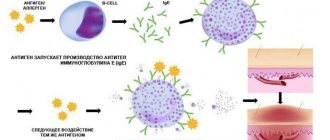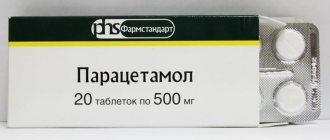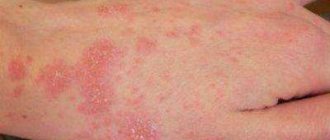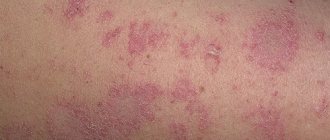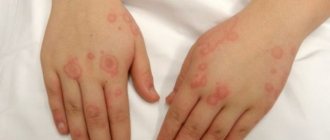Heat allergy or urticaria is a negative reaction of the human body to heat exposure and is rare. Despite the name, the origin of this reaction is not exclusively allergic. The causes are a whole complex of physical and biochemical factors. A distinctive feature of heat urticaria is that there is a clear connection between exposure to the skin and negative consequences. The irritant can be either sunlight or a heater, or hot air outdoors or indoors.
People susceptible to this disease usually experience exacerbations several times a year, they can vary in intensity. Symptoms include burning and itching of the skin and increased body temperature. In children, the disease occurs more often than in adults, in most cases it recedes by the time of puberty. In other cases, relapses can persist for decades.
From this material you will learn about heat allergies, what causes them, and who is susceptible to them. Also here you will find information about methods of diagnosis, prevention and treatment of the disease.
How to determine the disease?
Nowadays, we can name a number of factors that can provoke the development of allergic reactions. Some foods and even climatic conditions are irritants. In modern medical practice, allergies to heat and cold are increasingly being recorded. Similar reactions often occur in young children and young adults. At the same time, older people with particularly sensitive skin can also experience heat allergies. Symptoms and treatment are individual in each case. Therefore, everyone should remember about precautions when staying in direct sunlight for a long time.
Unfortunately, heat allergies (photos can be seen in this article) are quite common today. It should be admitted that many are not aware of the existing problem, believing that unpleasant symptoms are caused by their prolonged exposure to the sun.
What to do in this situation
The first and most important thing is to avoid being in the heat. You should go outside either early in the morning or in the evening. You will also have to give up vacationing in the hot south. In addition, during periods of extreme heat, you should stop doing fitness and sports. This can lead to an exacerbation of the disease, as the body will overheat during training.
Taking a contrast shower gives an excellent effect. You can go to the forest, to the river. Being in the shade and cool, periodically swimming in the river is also a good way to relax. It restores strength well, and does not provoke the appearance of disease. It is best to listen to the advice of specialists and adhere to a vitamin diet.
Who is at risk?
Most often, an allergic reaction to heat occurs in people with sensitive fair skin. In addition, children are usually susceptible to this disease. Currently, the causes of this disease are not fully understood. But today we can talk about several factors that contribute to the development of such a reaction:
- genetic predisposition;
- excessive drying of the skin;
- its increased sensitivity;
- excessive sweating;
- the presence of inflammatory processes on the skin;
- too long exposure to scorching rays;
- use of hormonal contraceptives;
- drinking alcoholic beverages on vacation, especially wine and champagne.
Treatment and complications
If the disease is not complicated by consequences, then its treatment can take place at home. It consists of drug therapy. The complex consists of:
- antihistamines. Cetrin, tavegil, suprastin are prescribed for oral administration, and fenistil-gel for topical use is prescribed to relieve skin manifestations. Doctors do not recommend taking second-generation antihistamines. Research shows that they increase the risk of developing cardiovascular disease;
- ointments with corticosteroids, these are prednisolone, advantan, hydrocortisone. They work to eliminate inflammation, due to which itching goes away, the skin stops cracking and getting wet in the affected areas, wounds heal faster;
- histamine receptor blockers, cimetidine, famotidine;
- preparations with diphenhydramine, for example, psilo-balm.
This is enough for systemic relief of an allergic reaction. To prevent recurrence, it is necessary to adhere to preventive measures, first of all, to follow a diet and the principles of a healthy lifestyle.
Delayed treatment or lack thereof leads to complications:
- asphyxia, anaphylactic shock, bronchospasm, angioedema, all of them can be fatal. They are not typical consequences of thermal urticaria; they are typical for any allergic process. But overreacting to heat increases the likelihood of their occurrence;
- swelling of the respiratory tract;
- when scratching - infection of the affected areas. It reaches a deep abscess with damage to fatty tissue.
To prevent the development of complications, it is necessary to seek medical help if general symptoms are detected. It is recommended to call an ambulance or go to the hospital yourself.
What foods are the most allergenic?
The consumption of the following foods poses a great risk to infants: fish and other seafood, eggs, nuts, honey, chocolate, citrus fruits, brightly colored berries, salty and spicy foods.
Products that contain preservatives and dyes can act as an allergen.
: mayonnaise, sauces, sausages, smoked meats, carbonated drinks.
Cow's milk
can also lead to an allergic reaction. Therefore, its consumption should be limited. In most cases, the source of the allergy is cow's milk protein, which is part of the mixture.
All trigger foods should be written down on a separate sheet of paper and posted in a visible place. This will make it easier to monitor your diet.
6
What is heat urticaria?
This is a pathological process that has the properties of neurodermatitis and allergies; it is similar to these diseases in terms of symptoms and course. Heat exposure produces a lot of acetylcholine and increases sensitivity to histamine. But everything is not so simple, since temperature exposure alone cannot lead to the release of histamine.
The only exception is sunlight; the ultraviolet rays it contains can cause real allergies.
According to statistics, about 98% of patients with thermal dermatitis have previously experienced allergic reactions. It turns out that the process is secondary, it does not develop on its own, but becomes a complication of allergies. After puberty, 60 to 70% of patients recover, and remission often occurs, which is mistaken for recovery. In a chronic course, exacerbations occur 2-6 times a year. An allergist-immunologist specializes in treating the disease; in case of severe skin reactions, a dermatologist is involved.
Allergy to heat: symptoms, photos
Quite often, the disease manifests itself almost immediately under the influence of high temperatures, although this does not always happen. People who are prone to allergic reactions to heat begin to experience various unpleasant sensations. They are clearly expressed and quite specific. So, the disease manifests itself with the following symptoms:
- rash, often purulent throughout the body;
- severe swelling;
- skin redness;
- unbearable burning sensation;
- peeling of the skin.
Clinical manifestations
Symptoms of a heat allergy are manifested primarily by rashes - redness of the face, neck, arms, back, chest. In this case, the person experiences unbearable itching caused by blisters and small red spots covering the skin. This reaction is called “heat urticaria.”
Allergists recommend that people predisposed to allergic reactions plan their vacation so that it does not fall during the hottest period and take the necessary precautions:
- Visit the beach in the morning or at sunset;
- Stay less in the heat during the day;
- Avoid direct sunlight;
- Don't dress too warmly and make sure your skin breathes.
What are the symptoms of this disease?
The symptoms of the disease are difficult to miss. They appear as:
- Rash all over the body (sometimes with ulcers).
- Swelling.
- Redness of the skin.
- Burning sensations.
- Skin peeling.
Usually, all symptoms do not appear immediately, but after several hours or even days of staying in a hot room or under the scorching sun.
Many people are misled by such “late” symptoms, forcing them to look for the cause of the disease in completely wrong places.
Treatment of heat allergies
Let’s not hide the fact that this disease is unpleasant, which is why it can and should be fought. If you find yourself or your loved ones experiencing the symptoms described above, you need to contact a dermatologist and allergist. Only an experienced specialist will be able to select effective drugs that will relieve you of the problem in the shortest possible time.
We should not forget that a sudden allergic reaction may be associated with the development of various chronic infections or inflammatory processes. Therefore, experts usually recommend undergoing a full examination.
Folk remedies to solve the problem
Herbal remedies help relieve symptoms of the disease. Aloe juice is especially effective in this case. The leaves are washed and crushed. The juice can be squeezed out through gauze and lubricated with it on the affected areas. It quickly soothes the skin and eliminates itching.
Raw potato juice and cucumber are also effective remedies. Baths with chamomile, string or nettle help well. Cosmetic clay also produces positive results. It must be applied in a thin layer to the damaged areas.
Baths with a decoction of nettle or starch work no worse than the same measures with a series. You can take a decoction of stinging nettle orally. But you should remember that there is an allergic reaction and individual intolerance to any plant. Therefore, it is better to consult a specialist.
Chamomile or violet tea is very useful for allergies. It should be consumed instead of regular tea or coffee. It is generally not advisable to consume these drinks in case of allergic reactions of any type.
Decoctions from:
- propolis;
- calendula;
- burdock;
- dandelion;
- birch and so on.
All products will give positive results only if used correctly. In addition, it is necessary to observe the rules of caution and avoid going out into the sun unless necessary.
How does cold urticaria manifest?
A person can acquire this form of urticaria either by inheritance or during life. Acquired urticaria may appear in adolescence and completely disappear by the age of 20-25. But it also happens that the disease occurs in adult women over 30 years of age and occurs in an acute form.
To diagnose an allergic reaction (urticaria) to cold, you will have to do special temperature tests: apply an ice cube to the skin of the forearm for 2-4 minutes. And then evaluate the results within 15-20 minutes:
- if blisters, swelling and redness appear within 10 minutes, this is primary/secondary cold urticaria;
- all similar symptoms appeared only after 20-30 minutes - this is an apathetic allergy to cold;
- if there is no reaction, but a rash appears on the skin area, this is reflex cold urticaria.
And why? How does the body behave?
You know what the normal temperature of the human body is. 36.6! And if the temperature varies, the body is not very happy. Well, if you heat it up, won’t it vary? Cramps may begin, especially after physical activity. People sweat a lot, so they lose a lot of fluid, and no matter how much you replenish it, there are still not enough electrolytes. There may be thermal edema, and in order to avoid overheating, the blood vessels will dilate and blood will accumulate in the ankles.
Photo: Pinterest
If prickly red spots suddenly appear on the skin, this is a heat rash. The reason for its appearance is that the sweat pores are simply clogged. And the higher the temperature, the greater the risk of heatstroke!
How to help a sick child?
Unfortunately, children suffer from this disease no less often than adult patients. But it’s hard for parents to watch their baby suffer. Children's skin is very delicate and sensitive. In addition, children often do not know or understand how to protect themselves in the heat - they want to run and play in the sun all day.
Do not forget that the child’s body is extremely sensitive to potent medications. To protect your child from illness, it is necessary to minimize the baby’s exposure to the sun. If a child is allergic to heat and develops skin rashes, lubricate the affected areas with aloe juice. Try to explain to your child how to behave in hot weather.
Diagnostics
In order to undergo diagnostics to confirm heat allergies, you need to contact an allergist-immunologist. This is the main specialist supervising treatment; he can involve a dermatologist to carry out advanced diagnostic measures.
Basic diagnostic measures include:
- interviewing an adult patient or a child’s parents;
- drawing up an anamnesis, detailed information is required about the development of the condition, previous illnesses, family history, living conditions;
- examination to determine the condition of the skin layers;
- General and biochemical blood test.
Based on these measures, the doctor can determine what type of disturbing process it is. Provocative tests are often performed to assess the body's ability to tolerate heat. To do this, the patient must take a glass of hot water in his hand or immerse his hand in warm water; they also resort to subcutaneous administration of Carbacholine. These methods are used under the supervision of a specialist as a final confirmation of the diagnosis; a negative reaction to irritants allows one to confirm the presence of an allergy to heat.
If there are suspicions of the presence of concomitant pathological processes of an inflammatory or infectious nature, additional studies are carried out. This is a bacteriological and microscopic examination of the contents of papules or scrapings from the surface of the skin.
First aid
Not everyone can see a doctor immediately after symptoms of the disease appear for various reasons. Therefore, it is necessary to know how to independently provide first aid to a patient.
First of all, the victim should move to a cool place. If this doesn't help, apply a cold compress to the most affected parts of your body or take a cool shower.
View gallery
Hydrocortisone ointment, as well as essential oils of lavender and aloe vera, will help relieve irritation and itching.
Therapeutic measures
When symptoms of a heat allergy appear, treatment is primarily aimed at providing the necessary first aid and alleviating the general condition. Skin inflammation can be reduced by rubbing the affected areas with aloe juice, raw potato, cucumber, or simply applying a cold compress. In addition, the symptoms disappear if you go into the shade, take a cool shower or plunge into a bath, after adding starch or nettle infusion.
After this, you should contact a specialist who will find out whether the allergy to high temperature is caused by a chronic infection and prescribe the necessary course of treatment aimed at reducing the allergic reaction. Most often, antihistamines are sufficient.
In severe cases, systemic corticosteroids are prescribed.
Those who have been diagnosed with this disease need to reconsider their diet, excluding from it foods such as coffee (more about the symptoms of an allergy to coffee), smoked, fried, and fatty foods. Summer holidays should be planned in such a way as to avoid a dry, hot climate, if possible, replacing it with a more humid, even rainy one.
If this is not possible, then you need to remember first aid for this type of allergy. And also about possible complications - infection, which is often acquired through scratched wounds and blisters. In this case, there may be an increase in temperature, chills, fever, pain in the area of the damaged areas, and increased inflammatory processes. In addition, due to a violation of the integrity of the skin, scars can form.
As a rule, an allergy to heat that occurs in youth goes away completely within a few months or years.
proallergen.ru
Treatment with traditional methods
Along with traditional treatment methods that your doctor will prescribe for you, you can also resort to folk remedies. In fact, they are very effective in eliminating the discomfort that heat allergies cause. They save thousands of patients from such a serious problem, and they are inexpensive and publicly available.
- Traditional methods help to quickly get rid of the negative manifestations of the disease. In such a situation, juice from cucumbers, apples, and raw potatoes will quickly relieve itching and burning. To achieve a positive effect, just wipe the affected area of the skin with freshly squeezed juice.
- We have already talked about the benefits of a shower or a cool bath, but the treatment will be more effective if you add nettle decoction or starch to the water.
- Pink or white cosmetic clay has a beneficial effect on the condition of the skin. If the allergy manifests itself as a rash on the body, prepare an infusion of dead nettle. This remedy is taken orally 1/4 cup three times a day.
- Traditional healers recommend drinking a lot during an exacerbation. Tea made from chamomile, string, veronica or violet is suitable for this. This drink has a healing effect on the body and strengthens the immune system. In addition, it has a powerful antimicrobial and anti-inflammatory effect.
Preventive measures
Prevention of exacerbations is as follows:
- cessation of drinking alcohol, smoking, and psychoactive substances. An exception is antipsychotic medications prescribed by a doctor;
- creating a comfortable temperature environment. Installing climate control equipment at home, going for walks in the morning and evening, setting the optimal water temperature for swimming;
- exclusion of hot spices and foods from the diet;
- adherence to daily routine;
- absence of psycho-emotional and physical overload;
- preventive visits to a therapist;
- Immediate contact with an allergist if an exacerbation is suspected.
It is also important to protect yourself from contact with substances that cause a negative reaction or are suspected of being dangerous. This applies to aggressive household chemicals; details are in the material “How dangerous is an allergy to bleach.”
Thus, heat allergy is a complex of immune reactions that is observed and treated by an allergist-immunologist. To protect yourself from dangerous consequences, you need to seek help when you notice the first symptoms. In most cases, the prognosis for treatment is favorable. Compliance with preventive measures helps improve the quality of life.
Greenhouse conditions
Since the main culprit in the development of the disease is cold, it is precisely this that must be avoided. If the diagnosis is confirmed, reduce the time your child spends outside in winter.
• Make sure that he does not wash his face with soap at least an hour before leaving the house - all cosmetic cleansing products destroy the protective water-fat mantle of the skin.
• Half an hour before a walk, lubricate all exposed areas of the body with creams that protect from cold and wind, and apply hygienic lipstick to your lips.
• Use only cotton underwear. Synthetics and wool worsen hives.
• Swimming in the pool and hardening procedures are strictly contraindicated for children with cold allergies.
• Everything that could be a potential allergen should be excluded from the child's diet. Replace fried with stewed or baked, reduce the amount of salt and sugar. It is better to exclude citrus fruits and chocolate during treatment.
To treat or not?
Another mystery of cold allergy is its pattern of progression and ambiguous prognosis. There are cases when the disease disappeared as suddenly as it appeared. But another option is more common: without treatment, the manifestations gain strength, attacks become more frequent and occur not only in winter, but also in summer.
! In 11% of cases, cold allergies provoke the development of bronchial asthma .
For treatment, the same medications are used as for normal manifestations of allergies. But only a doctor can determine the drug, dosage and duration of use. Immunity supporting agents are prescribed as auxiliary drugs.
Antibiotics: what is important to remember when taking them
Recipe
Irritations caused by cold allergies are soothed by a decoction of pine or fir cones. They are ground in a meat grinder, poured with water and cooked over low heat for 30 minutes. Then cool, filter and wipe the decoction on irritated skin twice a day.
lisa.ru
Occurs quite often
food allergies in infants
. This is mainly due to the immaturity of the digestive organs. Their adaptation to the new environment continues throughout the first year of life. During this period, you need to strictly monitor the diet of the nursing mother or select the right formula if the child is bottle-fed.
1
Throat and lung problems in extreme heat
Abnormally high air temperatures in summer also harm those who suffer from bronchitis, pneumonia, bronchial asthma or other chronic respiratory diseases.
The person feels an acute lack of oxygen. He is literally suffocating. Also, often in the summer, children and adults suffer from colds, sore throats and pneumonia. This is due to the consumption of large quantities of cold drinks and ice cream, as well as being under air conditioning or in front of a draft. Sore throat is dangerous because if complicated, it can lead to disability, and pneumonia can lead to weakening of the entire body and even death.
To avoid such consequences, observe the following preventive measures: . Don't sit directly under the air conditioner. . Do not drink ice water in greedy sips. It is better to quench your thirst with cool water and small sips. . Avoid drafts. Awareness of the dangers of extreme heat in summer will allow you to take better care of your health and prevent serious consequences.
Summer in recent years
forces people to seek refuge from hot, dry and sunny weather. Residents of rural areas can hide from the heat in the shade of trees, at home or near bodies of water. But city dwellers have a much more difficult time, because they are forced to breathe day and night the stuffy air that comes from the hot asphalt of roads and the stone walls of their houses.
Abnormal heat
negatively affects a person. Due to excessive sweating, the water and salt balance in the body is disrupted, as a result of which the nutrition of muscle cells and the body's performance deteriorate, and the frequency of cardiovascular attacks increases. You should be wary of the effects of heat on the body, such as heatstroke and sunstroke. With these manifestations of heat, a person’s temperature rises, their pulse quickens, dizziness and nausea appear. In severe cases, loss of consciousness and convulsions may occur.
To prevent dehydration
During hot weather, your body needs to drink more clean water. During the hottest time, it is better not to drink a lot of liquid; it is better to drink the bulk of water in the evening and in the morning. At this time, the body has the opportunity to store moisture in the tissues. In hot weather, drink less water and eat ice cream or water-containing vegetables and fruits. These are tomatoes, watermelons, cucumbers. Drinking just water on hot days is not enough; it is better to drink mineral water containing potassium, calcium and magnesium. After all, the danger of abnormal heat is not only in dehydration of the body, but also in the loss of salts, which are excreted along with sweat. These salts are necessary for the body and must be replenished.
But from sweet carbonated soft drinks
“like Coca-Cola, Sprite and lemonades should be abandoned. They do not relieve the unpleasant feeling from the heat, but they can complicate the functioning of the kidneys and liver. Which is very undesirable for health, because the load on the kidneys during periods of abnormal heat increases sharply. In order to facilitate the normal functioning of all organs, it is necessary to avoid eating heavy food before bedtime; digesting it contributes to an increase in body temperature and increases sweating.
Adapt to the heat and help the body
Can products with an astringent taste. For example, persimmons, bananas, all vegetables and fruits, green and white. Meals during hot weather should not be dense; you should eat in portions 5 times a day. After eating, you should not drink water for 30 minutes, and then drink in rare small sips. Instead of hot dishes, you should give preference to cold dishes. For example, okroshka and cold vegetable soups.
Diving into cold water during extreme heat
Not recommended. A sharp change in body temperature can provoke a spasm of the heart vessels. Cool down in the shade before jumping into a pool or body of water. Also avoid ice-cold showers; cold water causes blood vessels to narrow and then expand even more. It is best to take a warm shower in hot weather, after which the air temperature will seem lower than it actually is.
Abnormal heat
It is also dangerous because at this time there is increased solar activity. Therefore, you need to sunbathe with all precautions. Try not to sunbathe from 12 noon to 4 pm; be sure to wear a hat while on the beach. It is best to lie under an umbrella; in extreme heat, wet a scarf and wrap it around your head. Since hot days increase UV exposure, be sure to apply high sun protection factor sunscreen and wear sunglasses. Be sure to take a bottle of mineral water with you.
During the heat
Take off your shoes as soon as possible and walk barefoot on the ground. This makes it possible to improve blood circulation and increase the overall tone of the body. After all, there are a large number of active points on the feet that affect the functioning of internal organs.
Intensely engage in sports and exercise
during abnormal heat it is impossible. They increase heat transfer five times, which can cause dehydration. When it's hot, relax in the shade on the beach instead of running or pedaling.
Do not wear synthetic or tight clothing
. Give preference to clothes made of cotton and linen; they will not impede the evaporation of moisture. Synthetic fabrics impede heat transfer processes and do not allow the skin to “breathe”. Also, during abnormal heat, avoid applying foundation and powder to your face. They clog the pores of the skin and make it difficult to breathe.
Abnormal heat
- it's the right time to quit smoking and drinking alcohol.
After all, drinking alcoholic beverages in hot weather is strictly prohibited, and smoking in such weather is especially dangerous for the health of both the smoker himself and those around him. Sweat in three streams
The body's first reaction to heat is active sweating. This is how thermoregulation occurs. In this regard, we are lucky - in animals the sweat glands are poorly developed and their thermoregulation occurs mainly through the mouth. The intensity of cooling of the body in hot weather directly depends on the volume and rate of evaporation of sweat from the surface of the body. In addition, fatty substances are also released through the sebaceous glands, which also contributes to more efficient sweating. Dehydration and water deficiency are not the main problem. The main thing is that the body loses salts and minerals along with sweat. Their deficiency directly affects the cardiovascular system and the functionality of the brain. Dehydration in hot weather directly depends on a person’s activity level. During intensive work or sports, moisture loss can amount to 5-6 liters. When walking in the open sun, sweating doubles, when running - 4-6 times. Not only elevated temperature, but also humidity seriously affects your well-being. A temperature of 40°C and a relative humidity of 30% is perceived by the body in the same way as a temperature of 30°C and a humidity of 80%.
Prevention measures
Heat allergies are much easier to prevent than to treat. If a person is diagnosed with this, he needs to follow preventive measures. To do this, you need to carefully plan your vacation and work in the summer. Avoid holidays in hot countries and try to minimize or completely eliminate visits to beaches. If you still really want to sunbathe, you can do it in doses in the morning, when the sun's rays are not yet very active.
The same can be said about working outside under the bright summer sun - only in the early morning or late evening. In very hot weather, all outdoor work must be canceled or rescheduled. If this is not possible, do not forget about the existence of sun umbrellas, glasses and, of course, hats.
A person prone to heat allergies should always have a bottle of water with him. Eliminate all physical activity that warms up the body and contributes to an even faster development of the disease. It is strictly contraindicated for people suffering from this disease to visit a bathhouse or sauna.
How to prevent the problem from occurring?
As mentioned above, it is better for a person suffering from such a problem not to go on vacation to hot countries, although if he is forced to live and stay in such places, then he should not forget about basic precautions. You should take a sun umbrella with you, and go to the beach only in the early morning or at sunset. It is not recommended to go outside during midday.
You should not risk your body and organism without a good reason. After all, this can become a serious health problem. By following these measures, you can avoid photodermatosis for a long time.
Return to contents
netrodinkam.ru
The first signs of summer allergies
Signs can be different, the most well-known of them are:
- Redness of the face, back, arms and neck;
- The appearance of red spots;
- The formation of small blisters that become very itchy.
Moreover, when a person goes into the shadows, these symptoms disappear after a short period of time. Many people face this problem, and it has already received its scientific name - “heat urticaria”.
To alleviate your condition in the heat, it is enough to take a dip in a cool shower, pool or sea. It is worth noting that people who notice symptoms of this kind should not fly on vacation to too hot countries. They should not engage in fitness and dancing, because they greatly increase their body temperature.
In the summer, patients come to doctors complaining of allergies caused by sunlight. Otherwise it is called “photosensitization of the body.” The symptoms in this case are almost the same as in the previous one. Severe itching begins, and some areas of the skin turn red. When a person goes into the shadows, everything goes away.
Diet for allergies
Doctors never tire of repeating to their patients that for the successful treatment of all types of this insidious disease, including heat allergies, it is necessary to follow a special diet. So, it helps eliminate skin rashes. It is recommended to include foods rich in vitamin C in the diet of an allergy sufferer. They are natural antihistamines. In addition, they enhance the regeneration of affected skin and accelerate the healing of blisters and wounds.
On topic: Origin and meaning of the word “bixa”
The source of vitamin C is food of plant origin: citrus fruits, kiwi, bell pepper, black currant, rose hips, sea buckthorn, potatoes. Most herbs are also rich in this vitamin; among the most common are the following: alfalfa and nettle, raspberry leaves, parsley, sorrel.
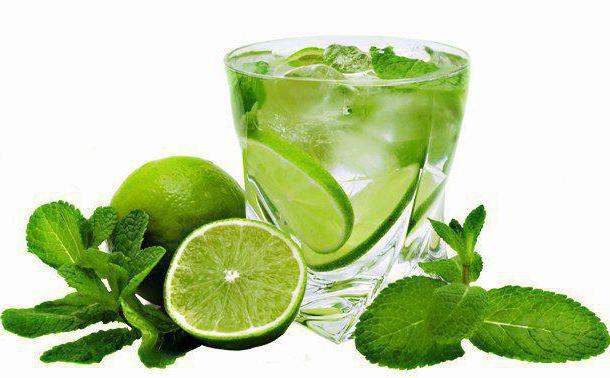
Fish and meat products contain significantly less of this vitamin, as do milk and eggs. Old potatoes retain only 15 mg of the vitamin (out of 25 mg in young vegetables).
conclusions
Seasonal allergy symptoms are unpleasant and have some similar symptoms to a cold or flu. However, fever or extreme fatigue are rare allergy symptoms.
Treatment is available, and limiting outdoor exposure to as many allergens as possible can help reduce the incidence of allergy symptoms.
We've selected related products based on product quality and listed the pros and cons of each to help you determine which ones will work best for you. We have partnerships with some of the companies who sell these products, which means Healthline UK and our partners may receive a share of the revenue if you make a purchase through the link(s) above.
Homeopathic medicines for the treatment of adenoids in children
The basis of homeopathy for adenoids in children is the anti-inflammatory effect and improvement of metabolic processes. Strict adherence to the recommendations of a homeopathic doctor and long-term treatment with such remedies makes it possible to avoid surgical intervention for adenoids in children. Doctors usually recommend thuja oil as a monotherapy.
Barberry Comp Job Baby has a complex effect. It contains thuja, iodine, berberis, and eupatorium. Complex aerosol Euphorbium compositum Nazentropen S is used for irrigating the throat cavity and contains several plant components.
Treatment of adenoids in children with the above drugs makes it possible to achieve resorption of the formations themselves. After just 6 months of taking such drugs, the inflammatory processes in the nasopharynx and throat that accompany adenoids cease. However, it is recommended to treat this childhood illness with homeopathy for at least a year with strict adherence to the doctor’s instructions and regular monitoring.
How do you know if it's a cold or an allergy?
Differences between colds, flu and allergies include:
- The allergy causes itchy, watery eyes. Colds and flu are not.
- Allergies may last throughout the season (about 6 weeks) or stop when the person is no longer exposed to allergens such as animal spores or mold. A cold usually lasts from 3 to 5 days, and the flu lasts from 7 to 10 days.
- Allergies usually do not cause the aches, pains, or severe exhaustion that the flu can cause.
